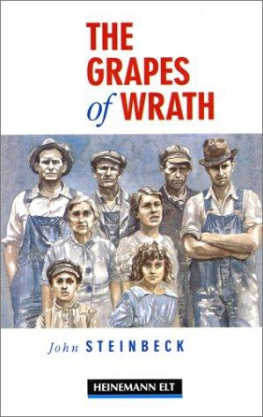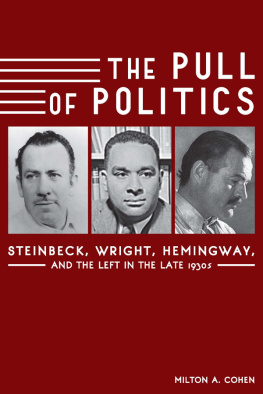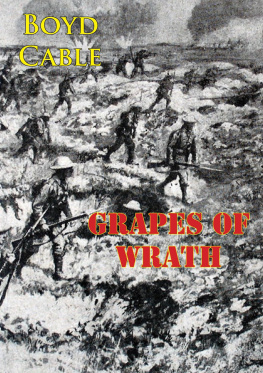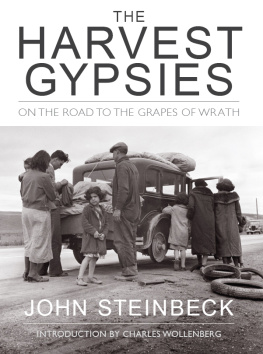PENGUIN BOOKS
The Grapes of Wrath
Born in Salinas, California, in 1902, John Steinbeck grew up in a fertile agricultural valley about twenty-five miles from the Pacific Coast and both valley and coast would serve as settings for some of his best fiction. In 1919 he went to Stanford University, where he intermittently enrolled in literature and writing courses until he left in 1925 without taking a degree. During the next five years he supported himself as a labourer and journalist in New York City, all the time working on his first novel, Cup of Gold (1929). After marriage and a move to Pacific Grove, he published two Californian fictions, The Pastures of Heaven (1932) and To a God Unknown (1933), and worked on short stories later collected in The Long Valley (1938). Popular success and financial security came only with Tortilla Flat (1935), stories about Montereys paisanos. A ceaseless experimenter throughout his career, Steinbeck changed course regularly. Three powerful novels of the late 1930s focused on the Californian labouring class: In Dubious Battle (1936), Of Mice and Men (1937) and the book considered by many his finest, The Grapes of Wrath (1939). Early in the 1940s, Steinbeck became a filmmaker with The Forgotten Village (1941) and a serious student of marine biology with Sea of Cortez (1941). He devoted his services to the war, writing Bombs Away (1942) and the controversial play-novelette The Moon is Down (1942). Cannery Row (1945), The Wayward Bus (1947), The Pearl (1947), A Russian Journal (1948), another experimental drama, Burning Bright (1950), and The Log from the Sea of Cortez (1951) preceded publication of the monumental East of Eden (1952), an ambitious saga of the Salinas Valley and his own familys history. The last decades of his life were spent in New York City and Sag Harbor with his third wife, with whom he travelled widely. Later books include Sweet Thursday (1954), The Short Reign of Pippin IV: A Fabrication (1957), Once There was a War (1958), The Winter of Our Discontent (1961), Travels with Charley in Search of America (1962), America and Americans (1966) and the post-humously published Journal of a Novel: The East of Eden Letters (1969), Viva Zapata! (1975), The Acts of King Arthur and His Noble Knights (1976) and Working Days: The Journals of The Grapes of Wrath (1989). He died in 1968, having won a Nobel Prize in 1962.
Robert DeMott is Edwin and Ruth Kennedy Distinguished Professor at Ohio University, where he has received numerous undergraduate and graduate teaching awards, including the Jeanette G. Grasselli Faculty Teaching Award in 1997. He is a former director of the Center for Steinbeck Studies at San Jose State University, and is currently on the Editorial Board of the Centers Steinbeck Newsletter. He is Editor (with Elaine Steinbeck as Special Consultant) of the Library of Americas three-volume edition of John Steinbecks writings, of which Novels and Stories, 19321937 (1994) and The Grapes of Wrath and Other Writings, 19361942 (1996) have so far appeared. His annotated edition of John Steinbecks Working Days: The Journals of The Grapes of Wrath was chosen as a New York Times Notable Book in 1989, and his Steinbecks Typewriter: Essays on His Art (1996) received the Nancy Dasher Book Award from the College English Association of Ohio in 1998.
JOHN STEINBECK
The Grapes of Wrath
With an Introduction by Robert DeMott

PENGUIN BOOKS
PENGUIN BOOKS
Published by the Penguin Group
Penguin Books Ltd, 27 Wrights Lane, London W8 5TZ, England
Penguin Putnam Inc., 375 Hudson Street, New York, New York 10014, USA
Penguin Books Australia Ltd, Ringwood, Victoria, Australia
Penguin Books Canada Ltd, 10 Alcorn Avenue, Toronto, Ontario, Canada M4V 3B2
Penguin Books India (P) Ltd, 11, Community Centre, Panchsheel Park, New Delhi 110 017, India
Penguin Books (NZ) Ltd, Private Bag 102902, NSMC, Auckland, New Zealand
Penguin Books (South Africa) (Pty) Ltd, 5 Watkins Street, Denver Ext 4, Johannesburg 2094, South Africa
Penguin Books Ltd, Registered Offices: Harmondsworth, Middlesex, England
First published in the USA by The Viking Press Inc. 1939
First published in Great Britain by William Heinemann Ltd 1939
Published in Penguin Books 1976
This edition published in the USA in Penguin Books 1992
Published in Great Britain in Penguin Classics 2000
1
Copyright 1939 by John Steinbeck
Copyright renewed John Steinbeck, 1967
Introduction copyright Penguin Putnam Inc., 1992
All rights reserved
The moral right of the author of the introduction has been asserted
Except in the United States of America, this book is sold subject
to the condition that it shall not, by way of trade or otherwise, be lent,
re-sold, hired out, or otherwise circulated without the publishers
prior consent in any form of binding or cover other than that in
which it is published and without a similar condition including this
condition being imposed on the subsequent purchaser
ToCAROLwho willed it.
ToTOMwho lived it.
Contents
Introduction
What some people find in religion a writer may find in his craft a
kind of breaking through to glory.
Steinbeck in a 1965 interview
I
On June 18, 1938, a little more than three weeks after starting The Grapes of Wrath, John Steinbeck confided in his daily journal (posthumously published as Working Days):
If I could do this book properly it would be one of the really fine books and a truly American book. But I am assailed with my own ignorance and inability. Ill just have to work from a background of these. Honesty. If I can keep an honesty it is all I can expect of my poor brain. If I can do that it will be all my lack of genius can produce. For no one else knows my lack of ability the way I do. I am pushing against it all the time.
Despite Steinbecks doubts, which were constant during its tumultuous process of composition, The Grapes of Wrath turned out to be not only a fine book, but the greatest of his seventeen novels. Steinbecks agressive mixture of native philosophy, common-sense politics, blue-collar radicalism, working-class characters, folk wisdom, and home-spun literary formall set to a bold, rhythmic style and nervy, raw dialoguequalified the novel as the American book he had set out to write. The novels titlefrom Julia Ward Howes Battle Hymn of the Republicwas clearly in the American grain: I like it because it is a march and this book is a kind of marchbecause it is in our own revolutionary tradition and because in reference to this book it has a large meaning, Steinbeck announced on September 10, 1938, to Elizabeth Otis, his literary agent.
After his arduous march of composition from late May through late October 1938(Never worked so hard in my life nor so long before, Steinbeck told Carl Wilhelmson), The Grapes of Wrath passed from his wifes typescript to published novel in a scant four months. In March 1939, when Steinbeck received copies from one of three advance printings, he told Pascal Covici, his editor at The Viking Press, that he was immensely pleased with them. The novels impressive physical and aesthetic appearance was the result of its imposing length (619 pages) and Elmer Haders striking dustjacket illustration (which pictured the exiled Joads looking out on a lush California valley). And true to Steinbecks insistence that
Next page










